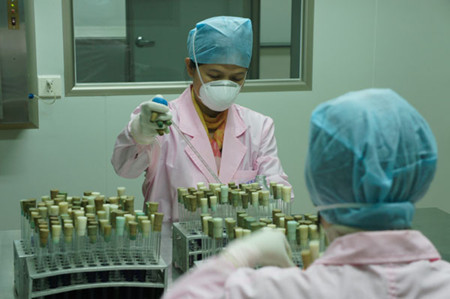
Monitors at the Liuzhou disease prevention and control center examine water samples from various parts of the city on Wednesday. The monitors take samples every few hours to ensure tap water supply to city residents. Lan Lin / for China Daily
The source of cadmium contamination in the Liujiang River had been blocked and tap water in Liuzhou is safe to drink, said environmental officials of the Guangxi Zhuang autonomous region on Wednesday.
Tap water from Liuzhou's four water plants was safe for drinking, Feng Zhennian, deputy director of the region's environmental protection bureau, told a news conference.
Polluted water detected in mid-January in the Longjiang River had flowed later into the Liujiang River, the water source for more than a million residents in Liuzhou.
Zhang Xiaojian, an expert with the river pollution task force, said on Wednesday: "The filtered cadmium will sink to the bottom of the riverbed. We will set up monitoring system and assess the environmental damage."
Cadmium is used in the manufacture of batteries, industrial paints and electroplating. Overexposure can damage the respiratory tract, liver and kidneys and can be fatal.
But Xiao Wenlian, director of the occupational health department of the Liuzhou disease control and prevention center, said the cadmium-tainted water would not cause direct damage to people's health immediately.
"Even if people drank seven liters of the water with a cadmium level twice the safety limit every day, only after 50 years of drinking it would cause kidney damage," Xiao said, adding there had been no reports of cadmium poisoning or tests for it in Liuzhou's hospitals.
Although authorities claimed they had taken steps to ensure water safety following a similar toxic spill in a South China river early in January, many users decided to shut off their taps.
"We will be using bottled water for drinking and cooking for about a month," said Xiao Deguan, a 61-year-old resident of Liuzhou city, on Wednesday.
Xiao sent her 1-year-old granddaughter to her relatives in Nanning, capital of Guangxi, after she heard about the spill.
Experts with the task force estimated about 20 metric tons of cadmium had been discharged into the Longjiang River on Jan 15 causing a cadmium content in the water 80 times higher than the safe limit, Xinhua News Agency reported.
The level dropped to 25 times the limit on Monday after thousands of tons of aluminum chloride and caustic soda were poured into the river and dams upriver increased the volume of discharges.
Some businesses have been hit by the pollution threat. A fish seller surnamed Wei in Huangcun market, Liuzhou, said she sold nothing on Wednesday because customers believed the fish were poisoned.
Those suspected of causing the pollution include heads of six metal companies and a zinc copper mine in Hechi, one of the country's leading mineral producers.
In 2005, two of China's largest zinc smelters were shut down temporarily after cadmium contaminated the Pearl River Delta and the Xiangjiang River, sources of drinking water for Hunan and Guangdong provinces.
In 2009, more than 500 villagers fell sick and two died after being exposed to cadmium that was illegally dumped into the Liuyang River by the Xianghe Chemical Plant in Liuyang, Central China's Hunan province.
Minister of Environmental Protection Zhou Shengxian said that in the first eight months of last year, there were 11 accidents involving heavy metal pollution.
In early 2011, China issued the 12th Five-Year Plan (2011-2015) on heavy metal pollution prevention and control, involving arsenic, lead, mercury, chromium and cadmium.

Copyright ©1999-2011 Chinanews.com. All rights reserved.
Reproduction in whole or in part without permission is prohibited.